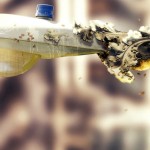 Trees are the most efficient oxygen-producing mechanisms known to man, so researchers have been trying to replicate them in order to produce breathable air in outer space. Julian Melchiorri, a student at the Royal College of Art, has created an artificial leaf that can produce endless oxygen using nothing more than light and water. The manmade leaves could be a game changer for space exploration, and they could also be used as biological air filters or oxygen producers back here on Earth. Trees do more than create oxygen; many of them also bear fruit. Artist Sam Van Aken has produced an amazing hybridized fruit tree that grows more than 40 different kinds of fruit , including peaches, apricots and almonds. Bees already do a lot of work for humans by pollinating crops and producing honey, but could they build our cities too? A pair of designers suggests that bees’ honey-making glands could be used to produce concrete instead, enabling them to 3D print structures . Even if that plan doesn’t work out, there’s still plenty to be learned from bees. Take honeycomb, for example: A team from the Stanford School of Engineering has made a breakthrough honeycomb lithium-ion battery design that could lead to more stable batteries for electric vehicles . And speaking of electric vehicles, this week Tesla and Panasonic signed a multimillion dollar deal for the world’s first battery-producing Gigafactory . What if you could build an entire house for just $3, 500 ? Architect Nicoló Bini, has developed a novel technique for doing just that — and it involves covering an inflatable balloon with concrete! In other green design news, Turkish architecture firm Autoban recently designed a set of futuristic wooden cocoons for Azerbaijan’s Baku Airport , lending the space a cozy, natural atmosphere. Cozier still, the Hanging Tent Company just unveiled a portable tent that hangs high in the treetops . The spherical tent features circular windows and a wood floor. And a 13-year-old from Georgia successfully built her own tiny house . The mini mansion features a kitchen, a lofted bed and a bathroom with a composting toilet. Looking ahead, Vo Trong Nghia has been selected to design the Vietnam Pavilion at the World Expo 2015 in Milan . The pavilion will be modeled after Vietnam’s national flower, the lotus. And filmmaker George Lucas has hired Studio Gang and MAD Architects to design a museum of narrative art in Chicago. In other green tech and innovation news, Amazon has launched an online store for 3D-printed objects . So far, the store offers 250 products, including pendants, toys, nylon wallets, cookie cutters and bobbleheads. A team from Australia obliterated a 26-year-old record for the world’s fastest long-range electric vehicle last week, traveling over 310 miles at an average speed of 62MPH. (The previous record was 45MPH.) Students from Goldsmiths, University of London created a pair of sneakers that are made entirely from plastic trash found on the beach . The Montreal-based media and entertainment studio Moment Studio has created a luminous forest wonderland in Quebec . A team from MIT has developed a simple graphite sponge that soaks up water and converts it to steam using solar energy. And digital tattoos could soon become a reality : The Silicon Valley firm VivaLnk has partnered with Motorola to offer up temporary tattoos that enable you to unlock your phone with a simple tap. And in case you still need a reason to say goodbye to your incandescent light bulbs, this infographic makes a bulletproof case . Filed under: Misc , Internet Comments
Trees are the most efficient oxygen-producing mechanisms known to man, so researchers have been trying to replicate them in order to produce breathable air in outer space. Julian Melchiorri, a student at the Royal College of Art, has created an artificial leaf that can produce endless oxygen using nothing more than light and water. The manmade leaves could be a game changer for space exploration, and they could also be used as biological air filters or oxygen producers back here on Earth. Trees do more than create oxygen; many of them also bear fruit. Artist Sam Van Aken has produced an amazing hybridized fruit tree that grows more than 40 different kinds of fruit , including peaches, apricots and almonds. Bees already do a lot of work for humans by pollinating crops and producing honey, but could they build our cities too? A pair of designers suggests that bees’ honey-making glands could be used to produce concrete instead, enabling them to 3D print structures . Even if that plan doesn’t work out, there’s still plenty to be learned from bees. Take honeycomb, for example: A team from the Stanford School of Engineering has made a breakthrough honeycomb lithium-ion battery design that could lead to more stable batteries for electric vehicles . And speaking of electric vehicles, this week Tesla and Panasonic signed a multimillion dollar deal for the world’s first battery-producing Gigafactory . What if you could build an entire house for just $3, 500 ? Architect Nicoló Bini, has developed a novel technique for doing just that — and it involves covering an inflatable balloon with concrete! In other green design news, Turkish architecture firm Autoban recently designed a set of futuristic wooden cocoons for Azerbaijan’s Baku Airport , lending the space a cozy, natural atmosphere. Cozier still, the Hanging Tent Company just unveiled a portable tent that hangs high in the treetops . The spherical tent features circular windows and a wood floor. And a 13-year-old from Georgia successfully built her own tiny house . The mini mansion features a kitchen, a lofted bed and a bathroom with a composting toilet. Looking ahead, Vo Trong Nghia has been selected to design the Vietnam Pavilion at the World Expo 2015 in Milan . The pavilion will be modeled after Vietnam’s national flower, the lotus. And filmmaker George Lucas has hired Studio Gang and MAD Architects to design a museum of narrative art in Chicago. In other green tech and innovation news, Amazon has launched an online store for 3D-printed objects . So far, the store offers 250 products, including pendants, toys, nylon wallets, cookie cutters and bobbleheads. A team from Australia obliterated a 26-year-old record for the world’s fastest long-range electric vehicle last week, traveling over 310 miles at an average speed of 62MPH. (The previous record was 45MPH.) Students from Goldsmiths, University of London created a pair of sneakers that are made entirely from plastic trash found on the beach . The Montreal-based media and entertainment studio Moment Studio has created a luminous forest wonderland in Quebec . A team from MIT has developed a simple graphite sponge that soaks up water and converts it to steam using solar energy. And digital tattoos could soon become a reality : The Silicon Valley firm VivaLnk has partnered with Motorola to offer up temporary tattoos that enable you to unlock your phone with a simple tap. And in case you still need a reason to say goodbye to your incandescent light bulbs, this infographic makes a bulletproof case . Filed under: Misc , Internet Comments
View article:
Inhabitat’s Week in Green: concrete honey, hybridized fruit tree and a $3,500 house






